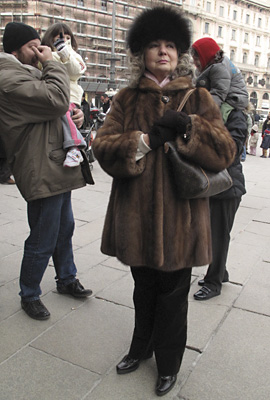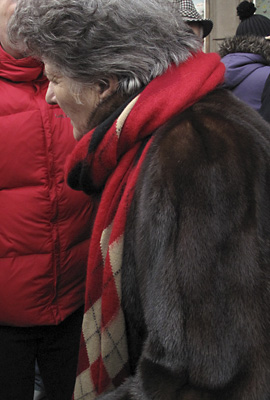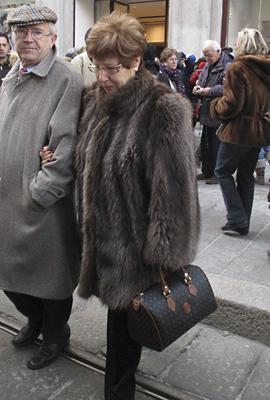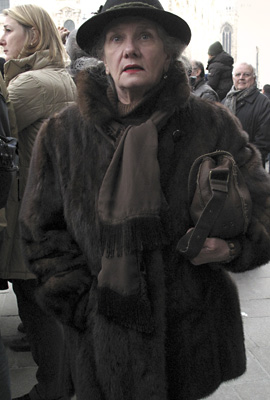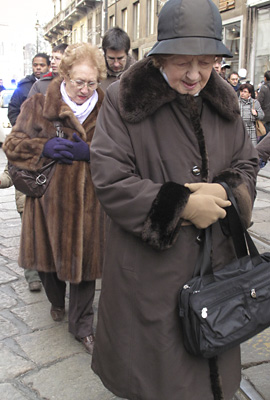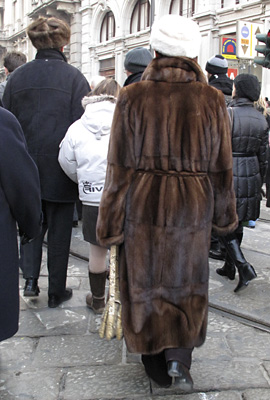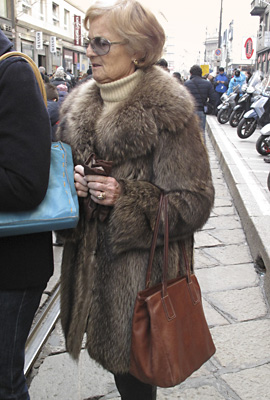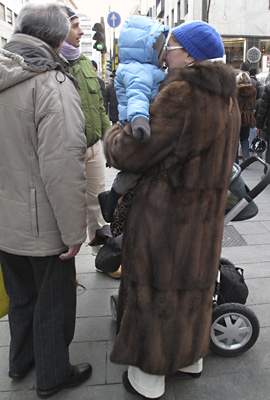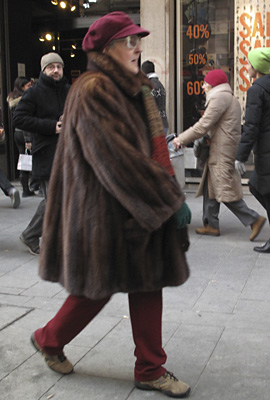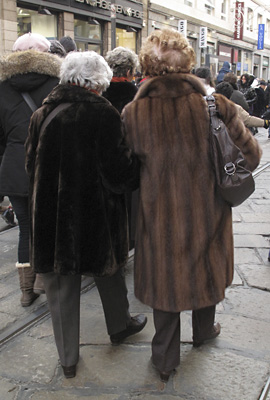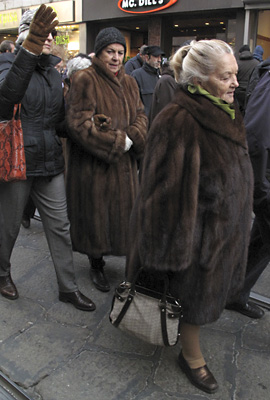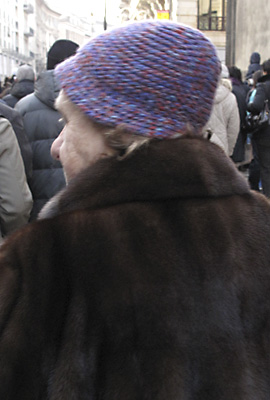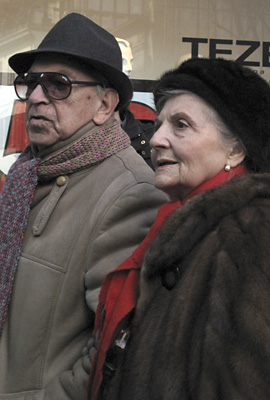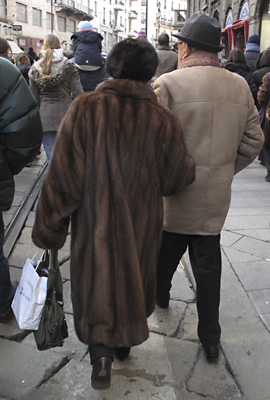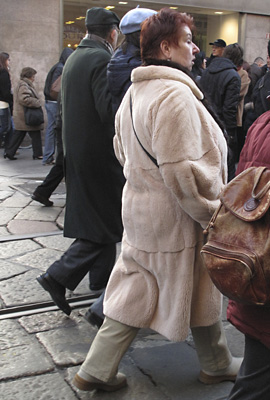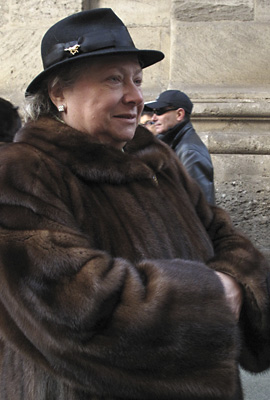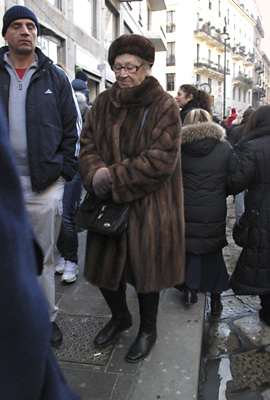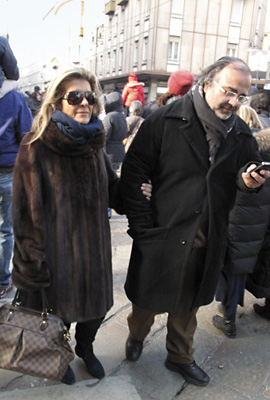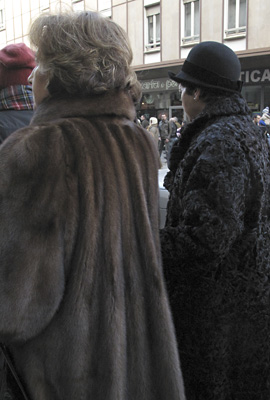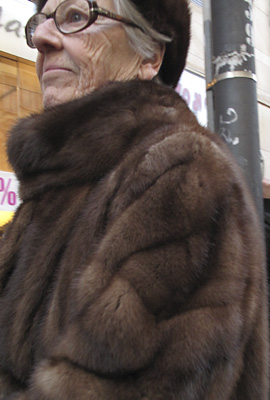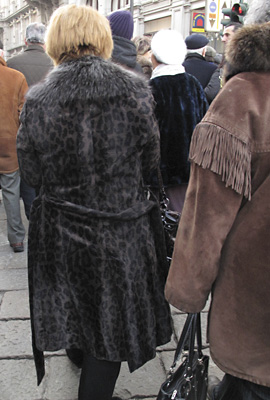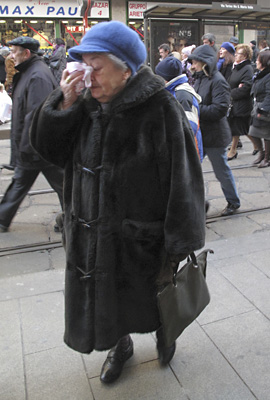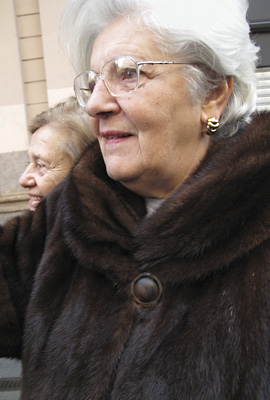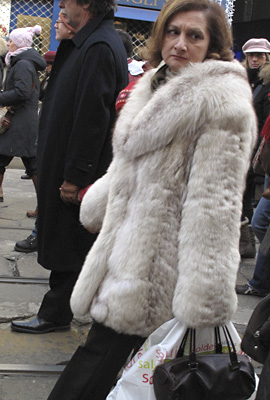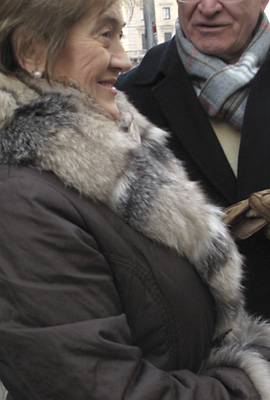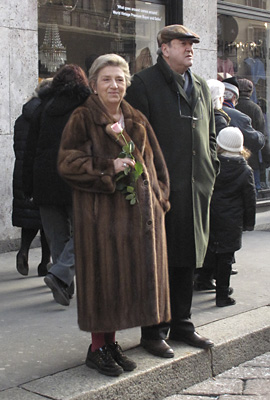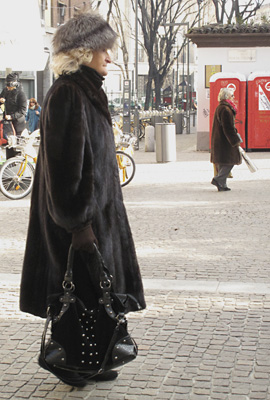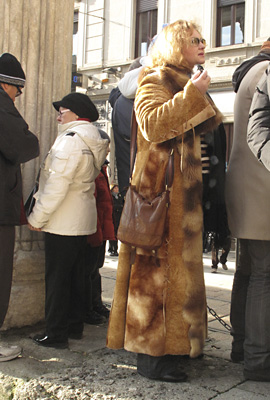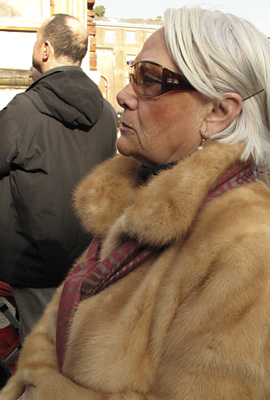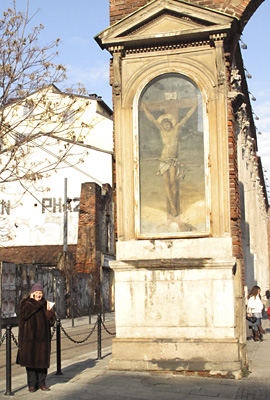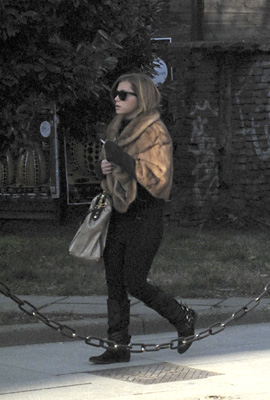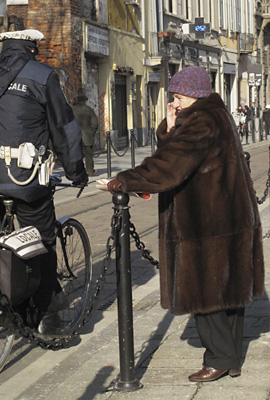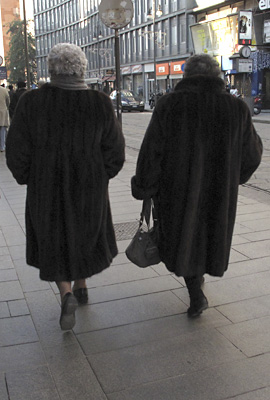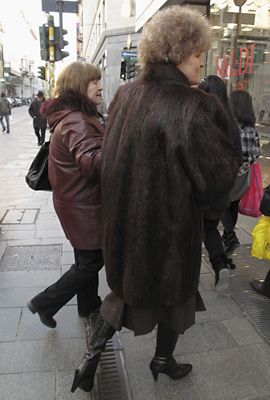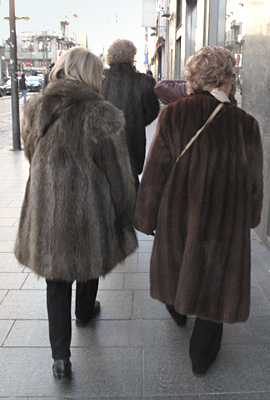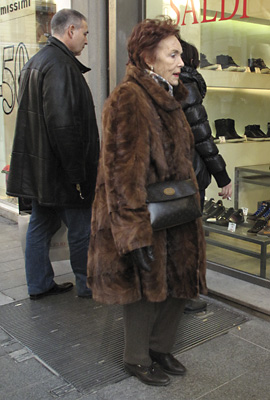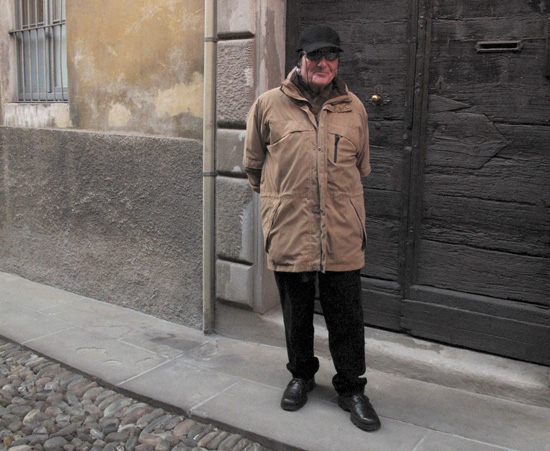
by Maureen | Jan 26, 2010 | Bergamo, Cheese, Discoveries, Featured Articles, Food!, Incredible Locations, Journal, Photos, Shopping & Markets
For 4 Euro and 20 cents – about $6.00 – each way, I was able to hop on the train and take a 45 minute ride to Bergamo, east-north-east of Milan.
Amazing amazingness. I’m still picking my chin up off the floor. I’m in awe that I can spend just a few dollars and in less than an hour be walking around in a walled city up on a hill, that was occupied by the Romans in the second century B.C.
They say that the name “Bergamo” has Celtic origins from the word “Bergheim”, “Home on the Mountain”. From what I read, the Celts inhabited the city and built the wall before the Romans took possession. And the story goes on from there.
I arrived at the train station in the “cittá bassa”, the lower city of Bergamo, then started walking in the direction of the upper city, the “cittá alta”. The two are quite separate and distinct from each other in appearance and identity. When I reached the lower “funiculare”, or tram station, I hopped on. I wanted to get UP.
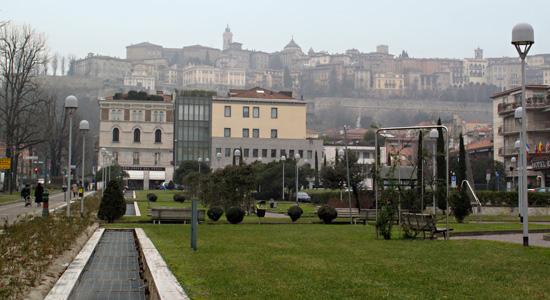
As I walked from the train station toward the “Cittá Alta” I caught this glimpse of the city above me.
By 11:00 in the morning I was walking on those roads made of upended, round cobbles. They’re actually quite uncomfortable to tread on, but they’ve also been designed with footpath-wide stripes of flat stone. How smart!
In these towns, it’s a thrill to wander the main route and browse the shop fronts, but also – even more so – to get away from main street and explore the back roads.
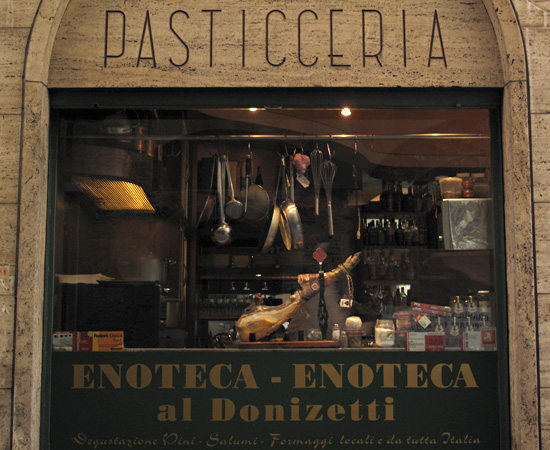
Would you ever see this in the U.S.? An animal’s leg, hoof-on, in the shop window? When a customer comes in, the store clerk steps over, carves away at the uncooked, aged hock, wraps up the meat and then goes on about the day.
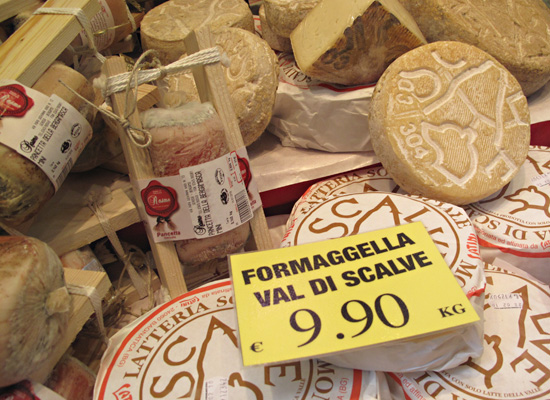
The imprinted cheeses are beautiful and I like the packaging on the (moldy) pancetta bound with wood.
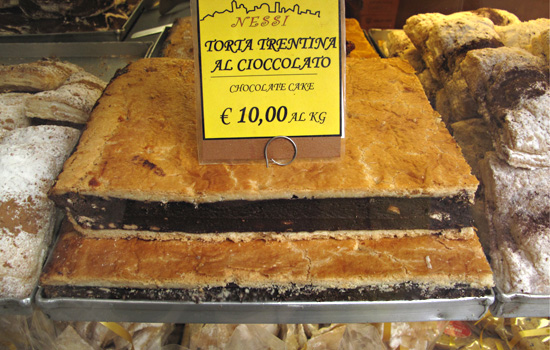
How could I NOT come back and buy some of this chocolate torte to bring home? It’s DENSE!
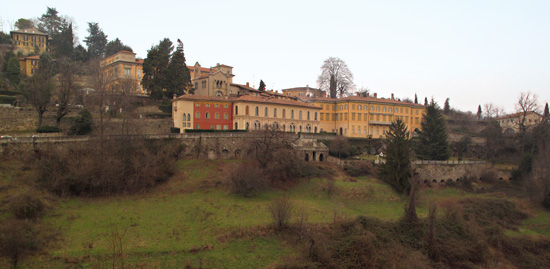
This is a view of the incredible places on the sweeping curve of the hillside, behind the wall.
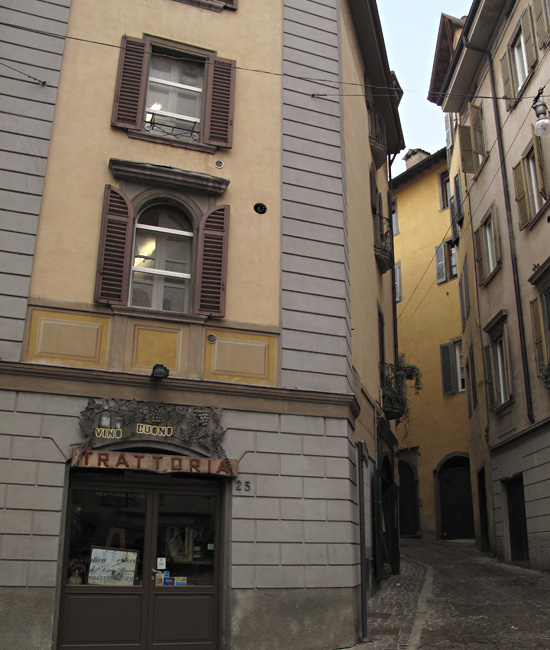
Towns like this beg to be explored, and the little “trattorie” beg to be sampled.
Bergamo reminds me of other places I’ve visited: San Gimignano, Siena, Venezia, Monteriggioni, Lucca, St. Angelo… There are hardly much more than footpaths in a rabbit warren fashion within the bounds of these cities. One car CAN fit on the streets of Bergamo, but just barely, and with difficulty if there’s also a pedestrian trying to get through. (Some of the cities I just listed don’t have any cars within them!) The narrow, shaded, no-end-in-sight passages generate such intrigue. What’s around the next bend?
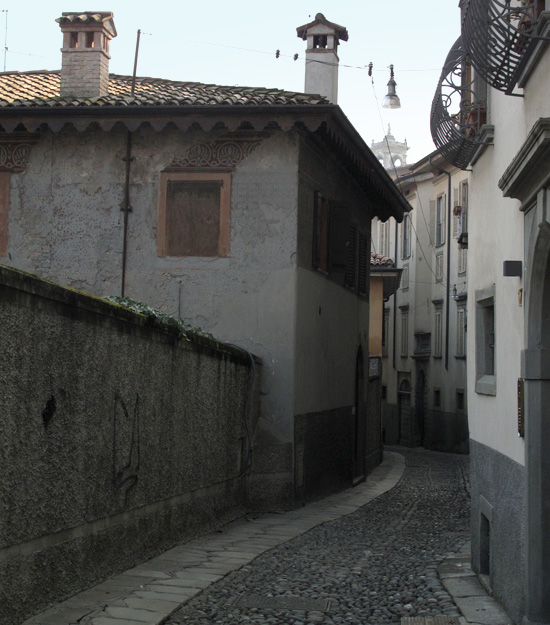
There’s fresco decoration just under the roofline of the house on the left. The round pebbles would provide good traction, but the flat stones at left are so much more comfortable to walk on.
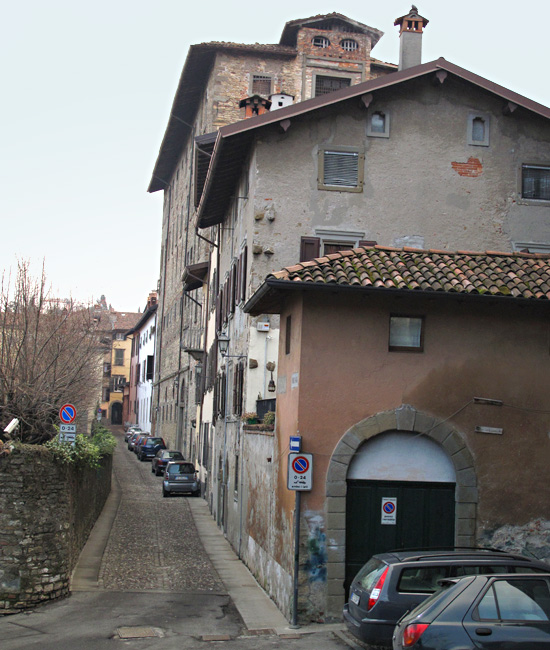
Park where you can. These homes look out over the valley below.
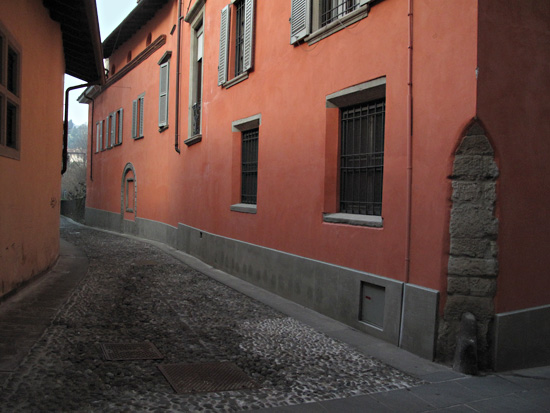
This is the side wall of the convent of the Domenican Nuns. I love their splash of color!
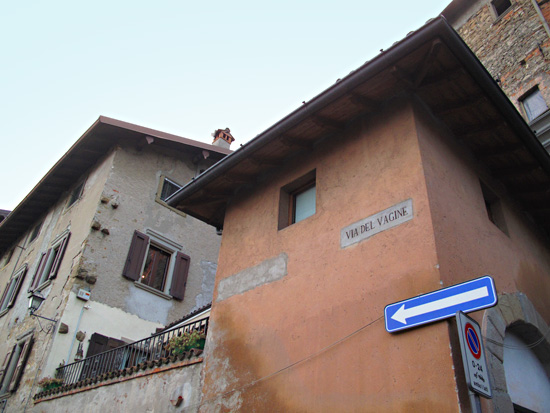
Why is the road leading to the convent called the “Way of the Vaginas”? (I’m sorry, but the question just had to be asked.)
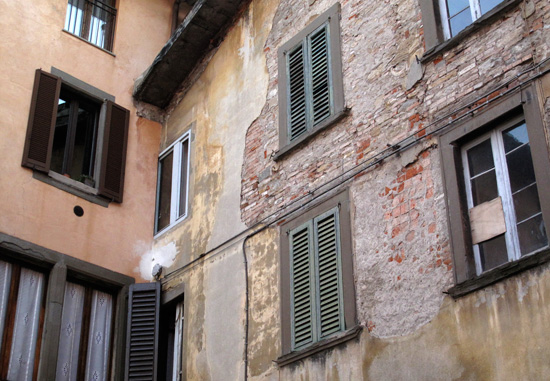
One of the things that so excites my mind is the layering of history in these towns, a result of demolition, restoration, remodeling, war destruction, weather, repair, embellishment.
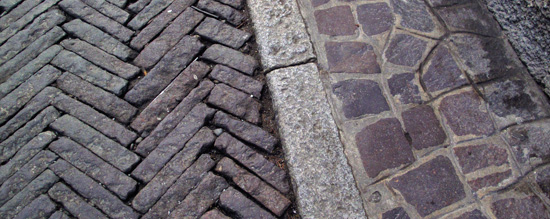
Left to right: street, curb and sidewalk.
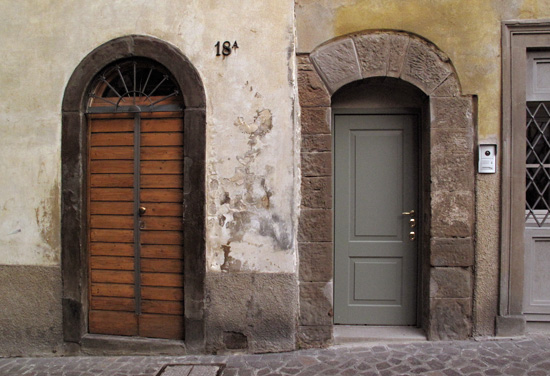
Some doors have fresh coats of paint. Some show the patina of wear, hand oils creating a sheen from use.
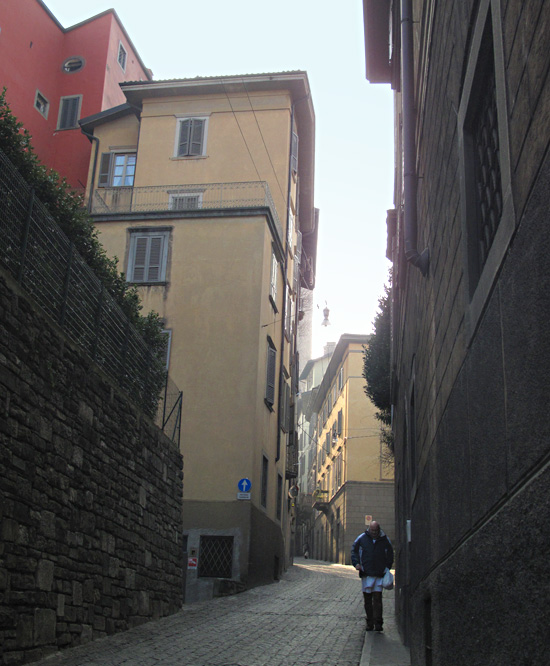
A walking town on a hillside. Ideal for one’s health.
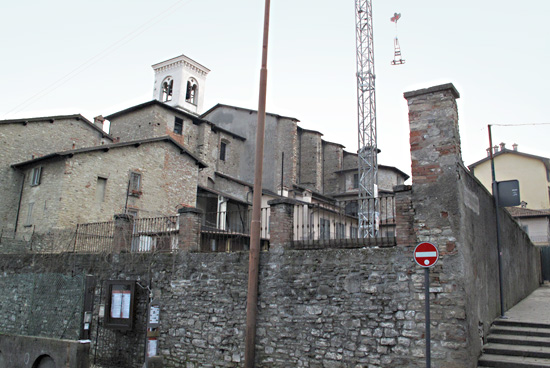
The construction crane is out of place with the old stone, but then again, it mimics the towers around it.
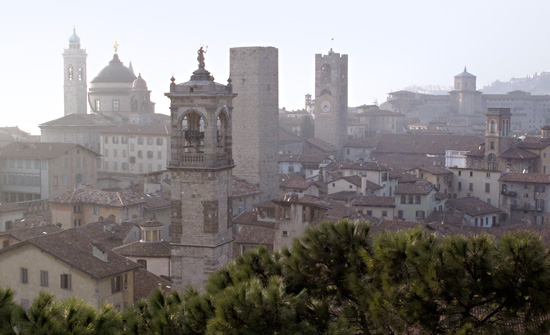
Late in the afternoon, I found my way to “La Rocca”, a tower, museum and military memorial. ALWAYS climb to the top of a tower in any city you visit!
At the end of the day, having explored the city and eaten a good meal, my camera battery was flashing red and I shot a few last images as the afternoon light waned. This door (below) caught my eye and demanded that I push the battery for just one more shot. When doing so, a man stopped to chat, saying that he, too, likes the old doors and is a sometime-painter. We talked about the longevity of wood versus stone and the absence of such ancient structures in the U.S. He asked where I’m from and when I told him I’m an American from Seattle, he said “But you speak such good Italian!” I smiled. We shook hands and wished each other well.

A painter that also loves the old doors.
by Maureen | Jan 20, 2010 | Discoveries, Food!, Journal, Shopping & Markets
I guess this blog site might be a turn-off to vegetarians. Sorry about that. I’m living in Italy. Not just meat, but RAW meat on the menu… and I eat it all. Shavings of raw lard. Ground up who-knows-what. Slices right off the moldy leg bone.
Bring it on.
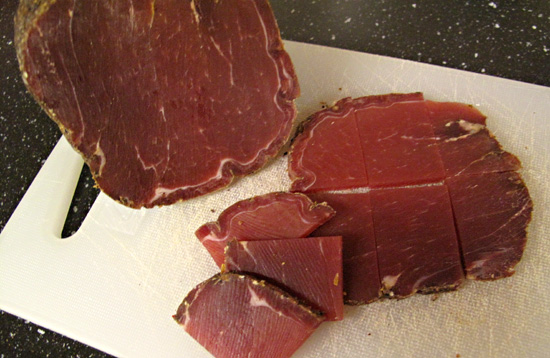
by Maureen | Jan 20, 2010 | Discoveries, Food!, Journal, Shopping & Markets
Mmm. It’s 10:00 p.m. and I just cut into a big chunk of Cinghiale Bresaola – uncooked, aged, wild boar meat. (Cinghiale: ching-GHYA-lay) Yum. So good. Peppered on the outside. Dense/firm. Deep red.

I bought it at the artisanal fair the beginning of last December when I sampled foods from every region in Italy. It’s been waiting for the right moment since then. The woman at the booth gave me samples of bresaola, lardo, prosciutto, salami… I didn’t need dinner that night!
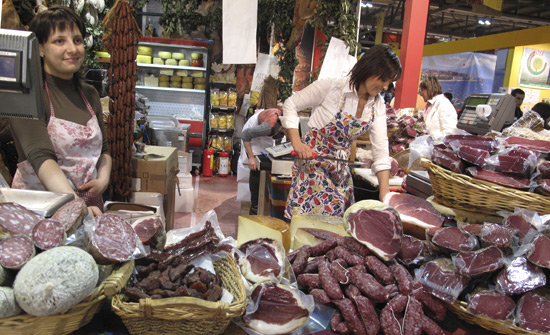
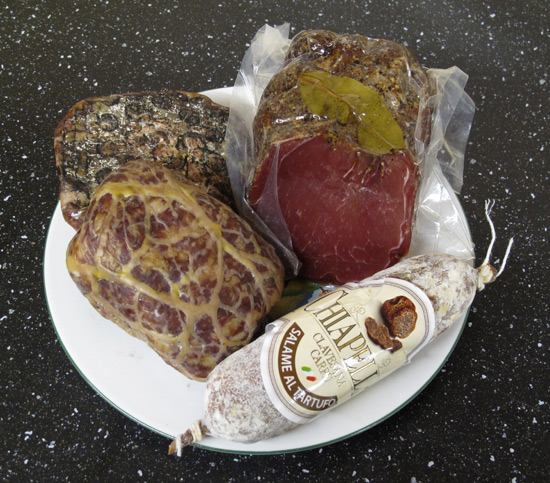
Here’s some further reading about cinghiale.
by Maureen | Jan 17, 2010 | Introspection, Journal
It’s an odd position to be in this limbo of not knowing how long I’ll stay in Italy. My original plan was to be here for a year, but as my Seattle departure date approached last June, I thought, and all my friends concurred, that one year might not be long enough.
I arrived in Milano. I got my apartment “comfortable enough for a year”, and I’ve settled in “just enough”. As it turns out, I’m more than a tourist, but not quite a real resident. I’ve got “short timer’s complex”. Uncomfortably, I am neither here nor there. Most friendships I make will likely be short term. Any household goods I buy will likely be the most minimal and least expensive “because I’m leaving sometime”. The emotional investment is greater than that of a tourist, but is still restricted. This is an odd phenomenon to have put myself in the middle of.
I arrived here June 18; it is now January 17, 7 months later. I know that I have a trip planned to Seattle in late Spring, and then again at the beginning of August. Will the flight in August be simply for a visit, or a return home “for good”?
There are more than 6 months in front of me during which I intend to be living here. Six months is many times more than most people can ever dream of being here in Italy, yet I’m feeling “the crunch” of departure. The other day an almost-panic set in and I started to think of all the things I haven’t seen or done yet in the last 7 months! Huh. So I started making my list of “Must-See, Must-Do”. Weird. I plan to be here AT LEAST for another 6-months-plus, yet my sights are already on departure in August. Ooo. Not good. Granted, that panic might fuel a frenzied string of weekend train trips to all-parts-Italy, plus a few flights to places more distant, but the MINDSET is what I’m concerned about. Focussing on departure means I’m not here, I’m already leaving. That doesn’t create a rootedness… But how does one root when she knows her time is limited?
Starting out with an imagined end-date has contributed to this limbo. But how does one have the boldness to say “I’m moving to Italy”, instead of “I’m moving to Italy for one year.” Whoa!!! Those two are ENTIRELY different in feel! Those two statements are worlds apart. I made the second choice, adding “…for one year”, and that colors my whole experience.
I constantly monitor personal and professional considerations when discerning the best time to return to Seattle – when my few belongings will be packed and shipped, my Milanese apartment will be vacated, and goodbyes will be said. The other day I recognized the push/pull of it. There are things here in Italy that pull me in to stay; there are things here that push me back. And Seattle – and the U.S. – have their own push/pull. All of it swirls and mixes and tumbles and stirs me deeply.
So, not having any solid answers, I’m making plans for Bergamo, Firenze, Savona, San Remo, Torino, Roma, Venezia, Sicilia and as much of Italy as I can lay my eyes on. And I intend to set foot in Germany, Spain, Greece, England, the Netherlands… and places I haven’t even conjured for myself yet. Hmm. Sounds like either a LOT of travel, or more than 6 months… or both.
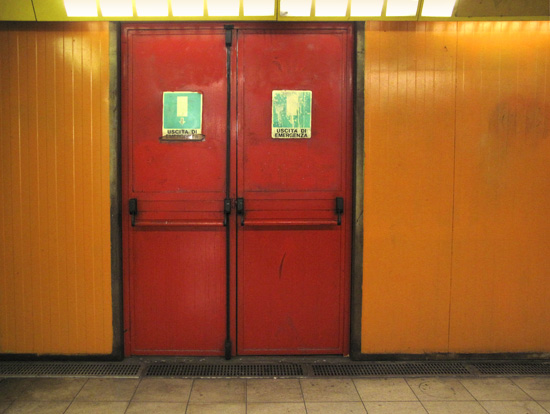
by Maureen | Jan 17, 2010 | Discoveries, Featured Articles, Journal, Photo of the Day, Photos, Quips
Getting out at Milano Centrale Metro Station to change from one line to another, I came up the escalator and was faced with this beautiful, colorful, tired doorway. Gorgeous.

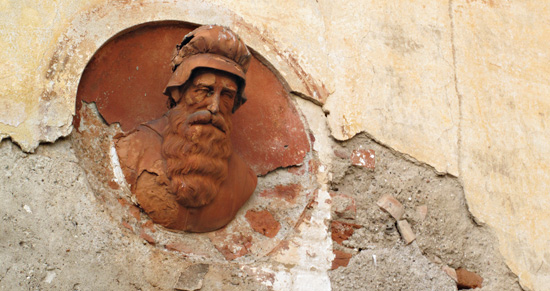
by Maureen | Jan 11, 2010 | Canals, Discoveries, Featured Articles, Incredible Locations, Journal, People, Photo of the Day, Photos
“I was born in 1945 during the war years and I grew up with family members all around me talking about politics and The War. They didn’t always agree. I think that being surrounded by these discussions as a child is why I love history so much today.”
Today Angelo became my second personal tour guide in two weeks, giving me yet another “3-hour-tour”. I just rode my bike all around the countryside southwest of Milano with my “History Buff on Wheels”.
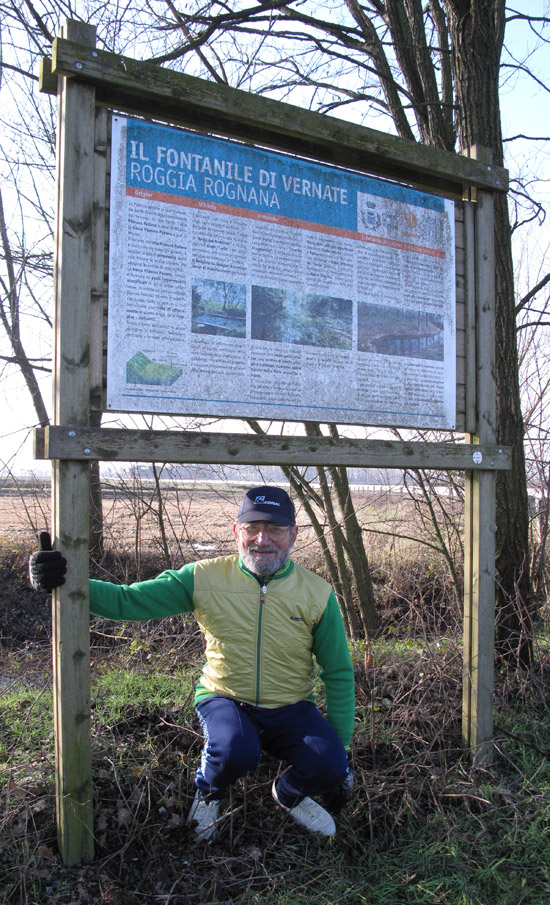
Angelo pointed out the “Fontanile di Vernate” one of the places where the spring forms a pond.
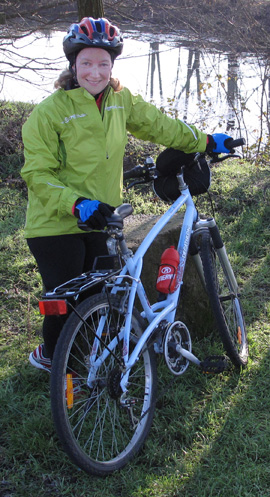
Oh yes. So lovely decked out in my winter riding gear…
When the sun came in the window this morning for the first time in ages, it woke me up and promised me a 45 degree day and my treasured, usual bike ride. I got the day, but not my usual ride. After pedaling along the Naviglio Pavese for about 20 minutes, I caught up with another rider and remarked how nice it was to be out. We talked for a minute or two as we rode, then I zipped ahead feeling full of energy and wanting to go faster. But he caught up with me. It was Angelo. We rode on, talking all the way. Feeling spontaneous and trusting, I agreed to his suggestion that we ride on further than I normally would have gone.
(I usually keep my rides to an hour and a half or two hours, and haven’t done much exploration alone on the more remote bike paths.)
Sure! Encounter some man on the bike trail and follow him all over the countryside! But of course!
We ended up riding on the narrow roads that wind between rice fields and other farm land. The whole time Angelo was relaying the history of Milan, Italy, Europe, WWII, Mussolini and Hitler… Berlusconi, Bush and Obama. He talked about the hardships during the wartime and how people were sustained by the rice of southwest Milano. (He doesn’t speak a word of English, by the way.)
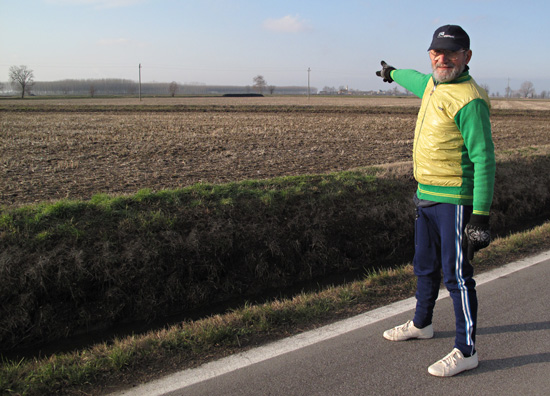
Angelo’s father’s birthplace is in the distance, where the church steeple is.
He pointed out where both his mother and father were born, and where they are both buried (Zibido San Giacomo). Angelo took me to old, fortified “cascine” – country farmsteads with castle-like main buildings and outbuildings – most refurbished and still in use as modern-day farms carrying on. He pointed out places where Leonardo da Vinci had been, worked, designed and created. Leonardo’s hand and mind are all over this local land.
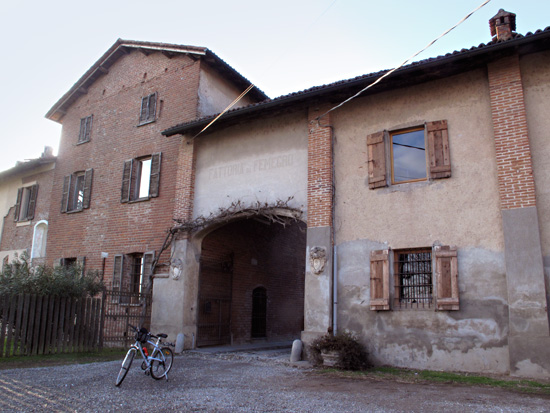
The entrance to Cascina Femegro.
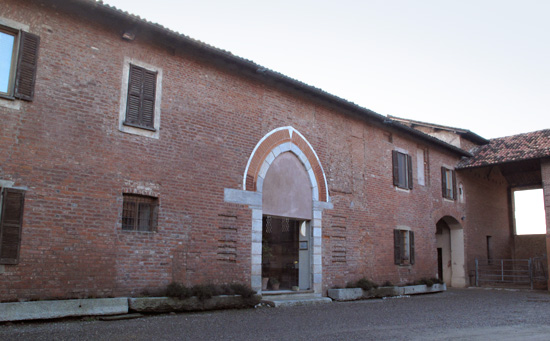
Within the inner courtyard of Cascina Femegro is this beautiful arched doorway. Straight across from it, 100 yards, are cattle in their stalls. A little girl was riding on her tricycle.
I saw a shrine in Zibido to Padre Pio (who had the “stigmata” markings matching Christ’s); the sarcophagus of San Giacomo, c. II-IX cent. – St. James – in the central courtyard of the town by the same name; and an old cascina, “Ca’ Grande”, Palazzina Pusteria Busca Pozzi.
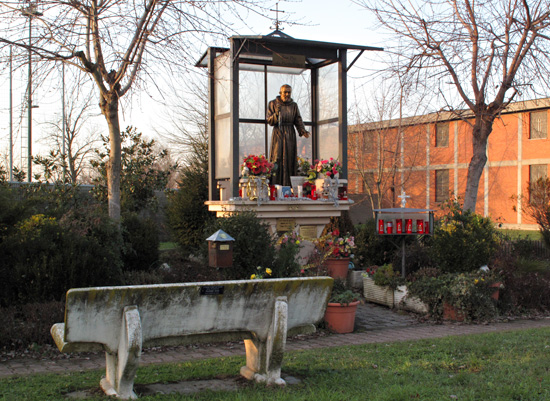
Shrine in Zibido to Padre Pio
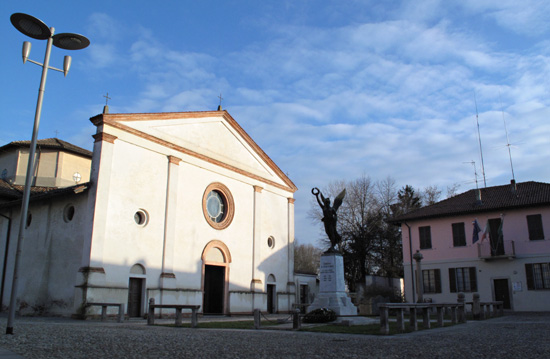
The church at Zibido San Giacomo.
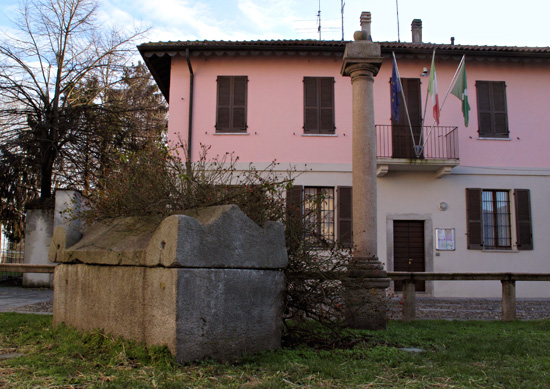
Sarcophagus of San Giacomo.
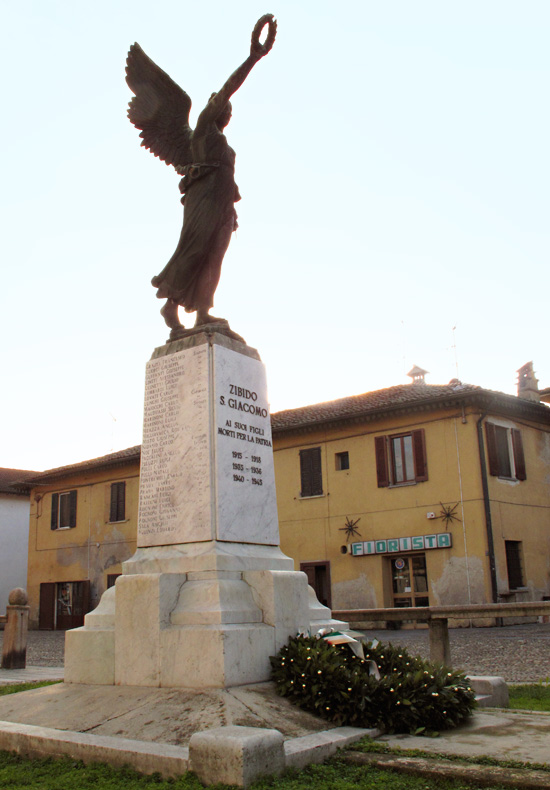
This is the memorial to those from the town of Zibido San Giacomo that have died in the wars.
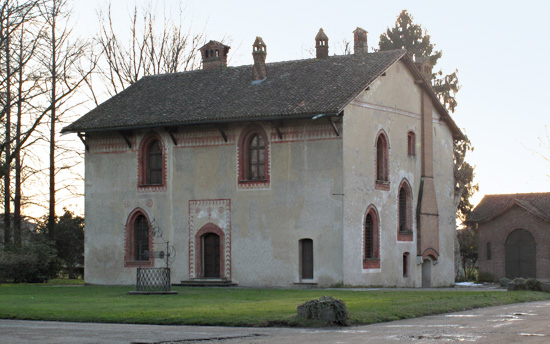
An old cascina, “Ca’ Grande”, Palazzina Pusteria Busca Pozzi.
(While riding through Zibido, Angelo’s daughter passed us in her car, going home. He rode to the house a half block away and told her about “this American woman”.)
Angelo explained the “marchite” – marshes – the rich, fertile land perennially wet from “i fontanili”, the underground aquifers and springs of the area. During the winter the ground’s surface may freeze but the ground itself is kept warm by the rising water. The farmed land has been formed into wide, humped rows, allowing the water to flow between the rows; the row peaks begin to grow grass earlier in the Spring than other locales. The milk from cows raised on this grass is said to be superlative.
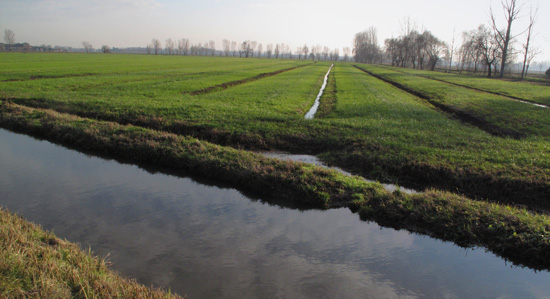
Le Marchite – The Marsh Farmlands
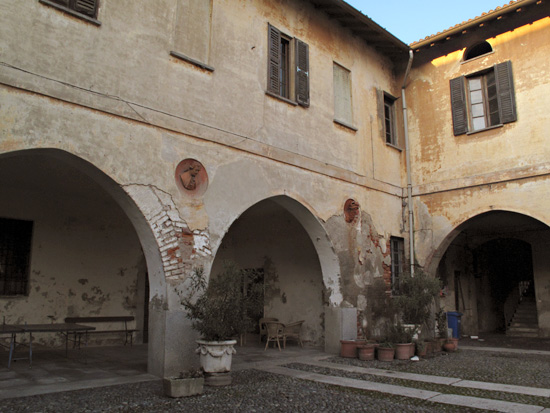
An old “cascino” back alongside the Naviglio Pavese, at the turnoff to Zibido; I think Angelo said it was “San Lorenzo”. Leonardo spent time here. In the inner courtyard, there are bas-relief busts of various people jutting from the walls.

We figured this one must be Leonardo.
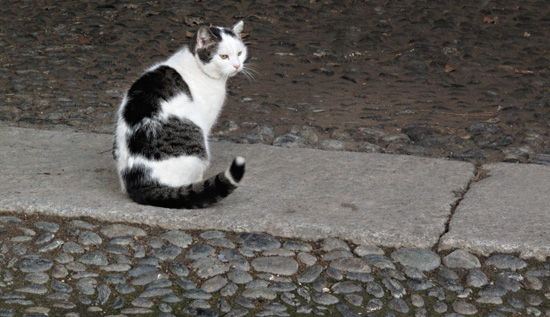
Of course there’s a cat in the courtyard!
Our route today was: South along the Naviglio Pavese to Binasco. West to Vernate and Calvignasco. North up through Rosate, back east to Noviglio, Mairano and Zibido San Giacomo. Angelo rode almost all the way back to Milano with me, to within 10 minutes of my apartment. He wanted to show me the maritime locks along the canal that Leonardo had designed.
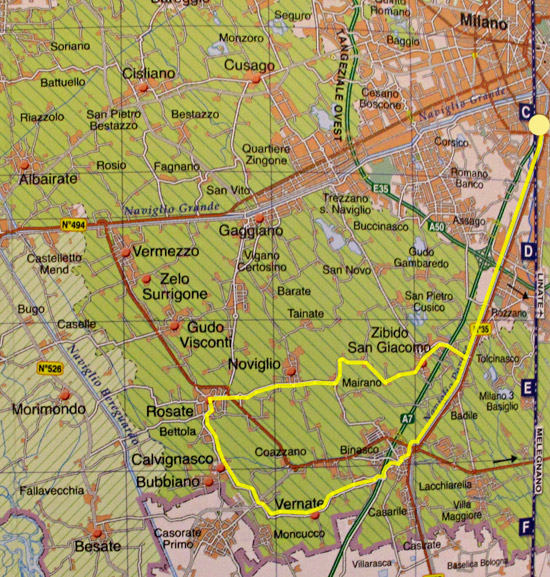
Our route – in yellow – through the farmland. My usual route is down the canal to Binasco and straight back. I’m going to feel this unusually long ride tomorrow!
He suggested I make a ride sometime to the Morimondo Abbey founded in 1136, and to the town of Vigevano to see a show of Leonardo’s work.
(I’m on stun. I could not craft these experiences if I tried!)
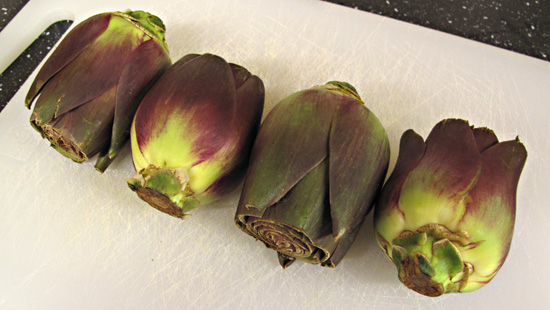
by Maureen | Jan 9, 2010 | Cheese, Christmas & New Year's Eve, Discoveries, Featured Articles, Food!, Journal, Meals, Photos, Shopping & Markets
Have you ever wondered about the first ones to eat something new that they hadn’t encountered before? IS it edible? What PART is edible? Should it be eaten RAW or COOKED? What part do you DISCARD? What part is most DELICIOUS? How is it best PREPARED? What should it be eaten WITH?
Traveling to and cooking in a foreign country is much like being a “primitive man” asking all those questions about newly encountered food items. But at least when you walk into a grocery store or step up to a market stall, someone has done the preselection for you and you’re not out in the woods trying to discern edibility. If it’s in the store, SOME part of it must be edible.
For the last couple of months I’ve been seeing these very small, young, almost-flower-like artichoke heads in the street markets and grocery stores. Very beautiful, but what do they DO with them?! I had no idea, and passed them up, regretfully. I had eaten marinated artichokes scooped out of little jars. Had steamed softball-sized heads and eaten them, leaf-by-leaf dipping the ends in butter. And I’ve eaten that sinfully fat-laden, hot dip with artichoke hearts, cheese, mayo and who knows what else. But I’d never done much else with them or seen them offered other ways. Yes, I’m sure the recipes and methods are out there, but the ones I just mentioned seem to be the across-the-board standards for eating artichokes.
On the evening of New Year’s Day, I was out walking around the Duomo and decided to have dinner out. I picked one of the few restaurants that were open, perused the menu and decided I HAD to have “Insalata di Carciofi Crudi” – Salad of Raw Artichokes! I ordered a “Pizza di Quatro Formaggi” – a four cheese pizza – to go with the salad, but that was secondary in my mind.
What arrived at my table was a bowl with paper thin shavings of very young, tender artichokes, including about an inch of the stem. They had been drizzled with a “fruttato” – “fruity” – extra virgin olive oil and lemon juice, sprinkled with salt and freshly ground pepper and tossed together with some thinly sliced grana cheese. Wow! Delicious! Simple, fresh in the middle of winter and quite a surprise. NOW I knew what could be done with those flowery artichokes.
Tonight, at the grocery store, I didn’t pass them up. They sold some untrimmed with thorny tips and 8 inches of stem, and they sold trimmed, packaged groups of 4. I considered the prices and how much would be thrown away from either and bought those that had been trimmed.
Usually, I would “just wing it” and approximate what I had tasted on New Year’s Day, but I decided to look online to see if there were any guidelines to follow. In doing so I found a handy Italian cooking website: Buonissimo.org. (Sorry. It’s all in Italian.) The recipe I found was what I had surmised and described above.

I removed the outer, half dozen tougher leaves and trimmed both ends to freshen them up. Then I cut the flower heads in half.
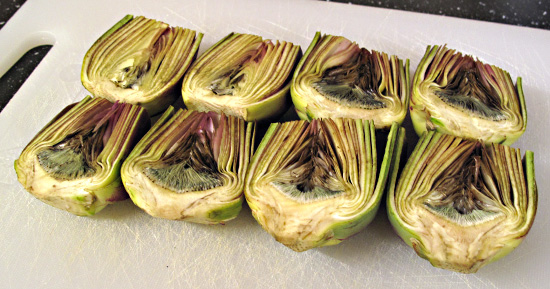
Since I don’t have a mandolin slicer here, I used my best Shun Tomato Knife, sharp and serrated, and sliced the artichokes as thinly as I could. (I left the furry inner parts, figuring they hadn’t gotten prickly.) I put it all in a bowl with the grana padano cheese (a nutty, almost sweet, hard cheese similar to parmesan), abundant lemon juice and extra virgin olive oil. Shook a little sea salt and grated some fresh pepper then gave it a gentle tossing.
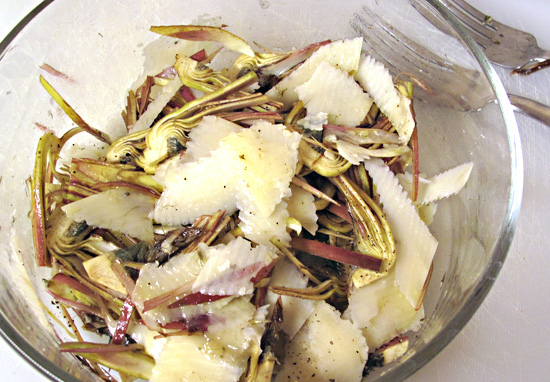
With my heaped serving of “Insalata di Carciofi Crudi”, I ate Norwegian, farm-raised salmon seasoned with Seattle’s Tom Douglas’ sweet/peppery Salmon Rub. The salad will become one of my new favorites. (If nothing else, it’s certainly good for the roughage!) But are the artichokian flowers available in the States?!
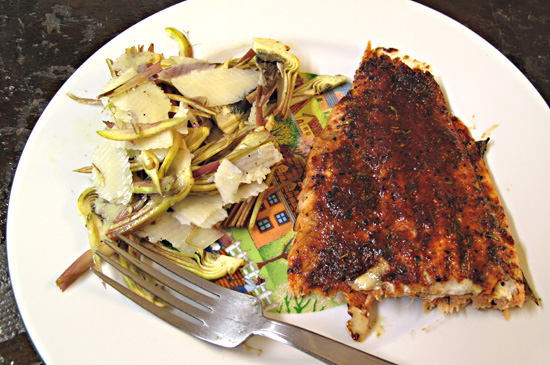
by Maureen | Jan 9, 2010 | Discoveries, Incredible Locations, Introspection, Journal, Paris
This whole time (Italy, France…) is a lesson for me that my life experience is entirely a reflection of what’s going on between my own ears. For instance, Americans always say “The French are arrogant and unfriendly!”, but I refused to walk around Paris with that belief and viewpoint. So I extended myself and was receptive to the friendliness that was offered and had an entirely different experience than what others might have come away with. I’m sure that if I had believed the French were arrogant, I could have found all sorts of experiences to prove that belief!
This is an example for all of life, no matter where I am or what I’m doing. My trip here a year and a half ago was an earlier, very concentrated lesson in this. I remember thinking then, “Gee, this is a reflection about living life, not just traveling in Italy.” So it has made me more flexible, more open to the unexpected, more willing to change my own thinking and see things from another angle.
I think that another purpose for my being here is to figure out what I’m really passionate about. This is a time to pause and hone my thoughts about what I really love to do, how I love to spend my time… and with whom. I’m here to figure out what I’m passionate enough about that it’ll carry me for the next 20 or 30 years.
(Right now, whittled down to simplicity, I know it has to do with writing, making images and forging connection and community.)
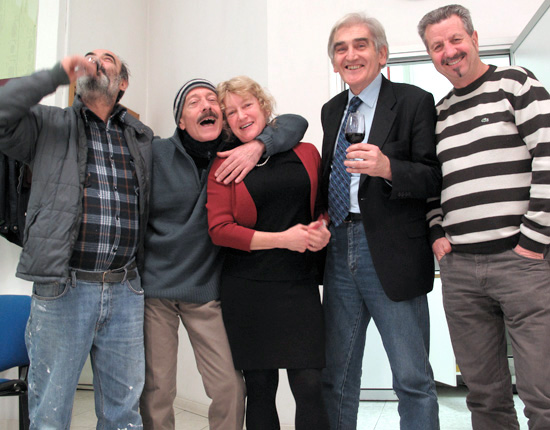
by Maureen | Jan 9, 2010 | Cheese, Discoveries, Featured Articles, Food!, Journal, Meals, People, Photos
“Maureen, there are a few of us having some appetizers and wine. Why don’t you come join us?”
It was Mario, the regional director for ONAV, the National Organization of Wine Tasters. We had met a few times at their wine-tasting events: Prosecco-tasting, Barbera- and Barolo-tasting, Champagne-tasting. I’m going to attend their 9 week course in wine-tasting, beginning in February. Any of their gatherings, formal or casual, are opportunities to sample some diverse and very special wines… and meet new people.
I took the Metro across town, walked two blocks and entered the ONAV classroom full of tables and chairs. These four guys – Michele, Vicenzo (giving me a choke-hold), Mario, Carlo – sat at a table cluttered with meats, breads, wine, oil and sweets. (The three are long-time friends of Mario, not with ONAV.) As you can see, it wasn’t a stuffy group.

We sampled a number of wines and also enjoyed a tasting of Extra Virgin Olive Oil from the San Gimignano region.
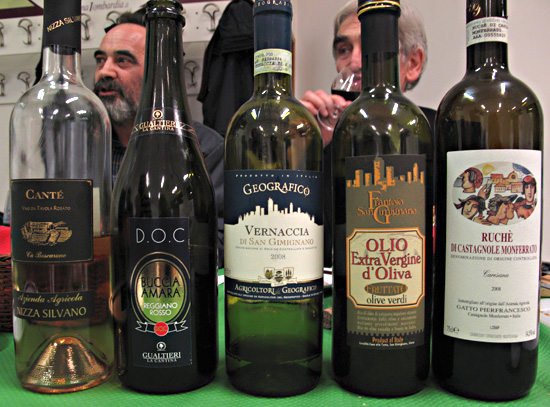
I didn’t realize until afterwards that I should have gotten a photo of Carlo in his striped sweater, with Vicenzo in his striped hat and me in my striped coat. It would have been a highly-visual photo. (Vicenzo asked if I know of any American women I could set him up with.)
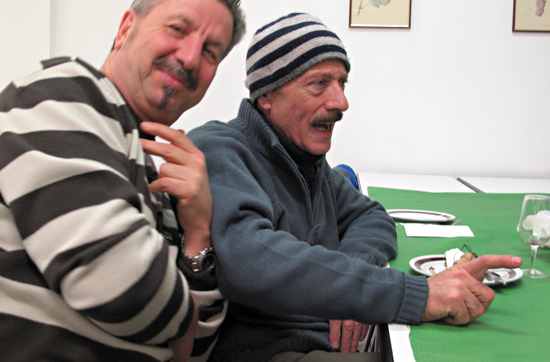
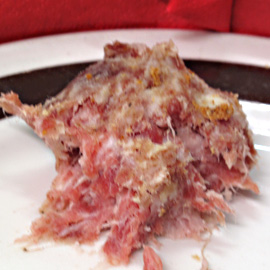 The table bore mortadella, salami and a raw, seasoned meat/fat combo that Mario simply peeled the casing off of and spread on bread. (I know the photo’s out of focus, but at least it gives you an idea of the meat’s appearance.) We ate from a large rustic loaf, a potato loaf, and Sicilian bread sticks and rounds.
The table bore mortadella, salami and a raw, seasoned meat/fat combo that Mario simply peeled the casing off of and spread on bread. (I know the photo’s out of focus, but at least it gives you an idea of the meat’s appearance.) We ate from a large rustic loaf, a potato loaf, and Sicilian bread sticks and rounds.
There was a bone-white spread of pecorino and ricotta cheeses pureéd together. And a special treat was the “Lardo di Colonnata”, raw, salted, herbed pig lard, aged at least six months and served as thin slices on bread. Mmm, good!
(I’ve become quite fond of eating raw meats and moldy cheeses.)
We drank a sparkling red, a white, a rosé. The most “startling” wine was the deep red Ruché (Roo-kay); I had never tasted anything like it with its very distinct flavor. (I’ll have a better vocabulary to describe it AFTER I take the class.) You could ask for Ruché* at your local specialty wine shop, but its very low production makes it unlikely that you’ll find any.
Our little post meal sweets were dried figs and apricots from Sicily, and almond pastilles that are frequently offered as favors at weddings. (In the States, too.)
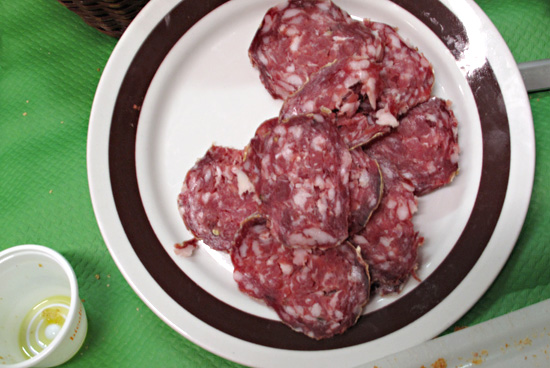
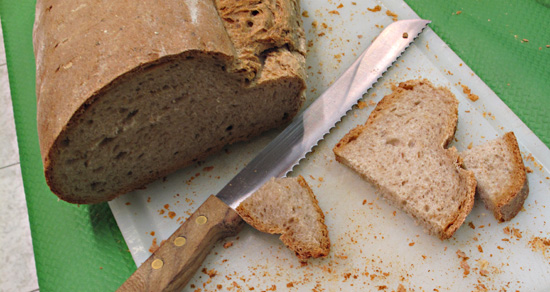
The very special end-note to the evening was a wonderful Passito di Pantelleria from the tiny little Island of Pantelleria, Italy, between Sicily and Tunisia. Passito, made from dried and shriveled moscato grapes, is a gorgeous amber color and a drink that requires every sip to be savored. I couldn’t keep my nose out of the glass; the scent was divine.
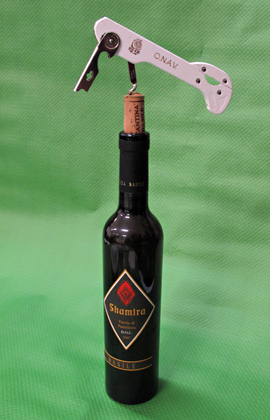
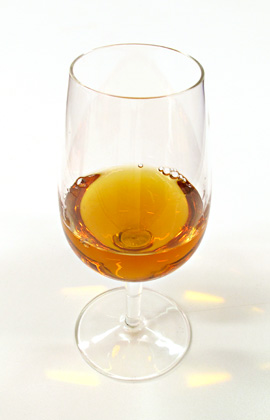
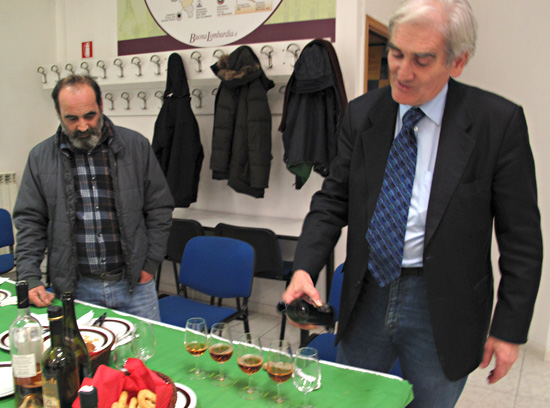
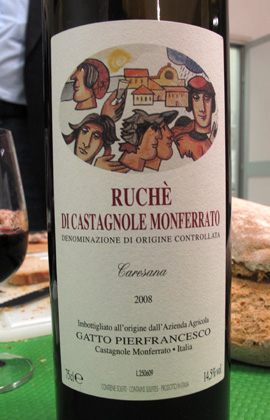
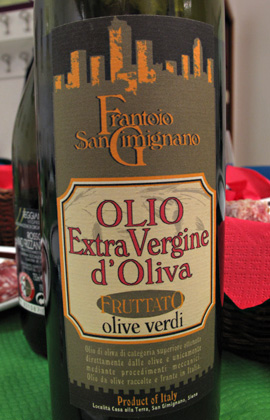
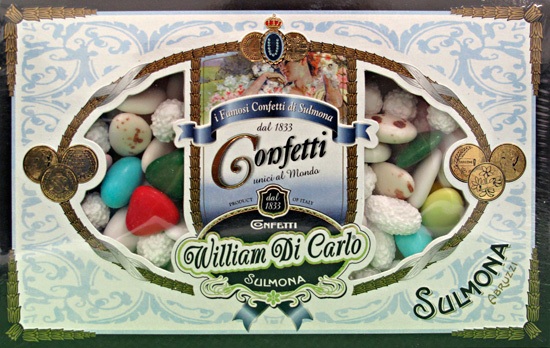
Below, on the right, is a bag of the not-fully-dried, shriveled moscato grapes used for making passito. You can eat them much like raisins.
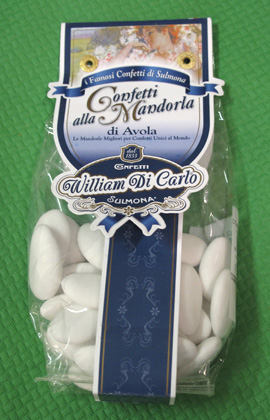
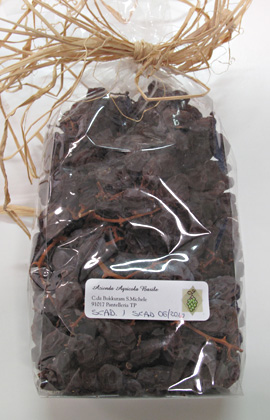
Ruché (from Wikipedia):
Ruché is a red Italian wine grape variety from the Piedmont region. It is largely used in making Ruché di Castagnole Monferrato, a small production red varietal winewhich was granted Denominazione di Origine Controllata (DOC) status by presidential decree on October 22, 1987. The current DOC recognized area of production for the wine, covers only about 100 acres [[40 hectares) of vines around the villages of Castagnole Monferrato, Refrancore, Grana, Montemagno, Viarigi, Scurzolengo andPortacomaro.[1] Ruché di Castagnole Monferrato is, therefore, one of the lowest production varietal wines in Italy. The grape is also grown to some extent in the neighboring province of Alessandria.
There is some debate about the origins of the Ruché grape. One theory is that the varietal is indigenous to the hills northeast of the town of Asti. Another theory is that the grape is a local variation on a French import. It has been grown in the area for at least one hundred years but has only recently been marketed and consumed outside of the immediate vicinity of its production. Ruché di Castagnole Monferrato tends to be medium bodied with notes of pepper and wild berries and floral aromason the nose.[2] The wine is often characterized by moderate acidity and soft tannins. In the Piedmont region it is often paired with slow-cooked beef, northern Italian cheeses and mushrooms.

by Maureen | Jan 7, 2010 | Discoveries, Featured Articles, Journal, People, Photos
Gotta love these Italians. They had two national, Catholic holidays at the beginning of December. Then two weeks off for Christmas and New Years. Then, today is the Feast of the Epiphany, also a national holiday. (Italy is about 98% Catholic.) A lot of people took this whole week off since they were already on a two week break and why come back for two days, have one day off, and then come back for two more days before the weekend? Might as well extend the two weeks into three.
There was a parade through town for the Epiphany. Actually two parades: the official one of Magi and Wise Men, then the parade of older, Milanese women in their fur coats. I must have seen a thousand fur coats today. Boggling.
After rain, snow, cold and gray, the 45 degree day brought the crowds out. It seemed that this must be the traditional time to strut one’s fur. Amazing. I was more amused by playing sleuth photographer and people-watching than I was by the pageant of the “real” parade.
(I shudder at some of the faces of these women. Some look cold and hard.)
The furs were worn with argyle, cashmere and hand-knit. With fur hats and berets. There were full-length, knee-length, sporty-short, wraps and stoles. There were SO many women in furs, that it was comical, an exaggeration. Was anyone else noticing?
